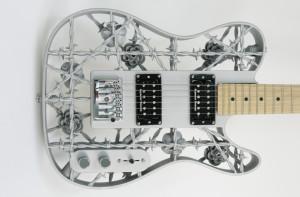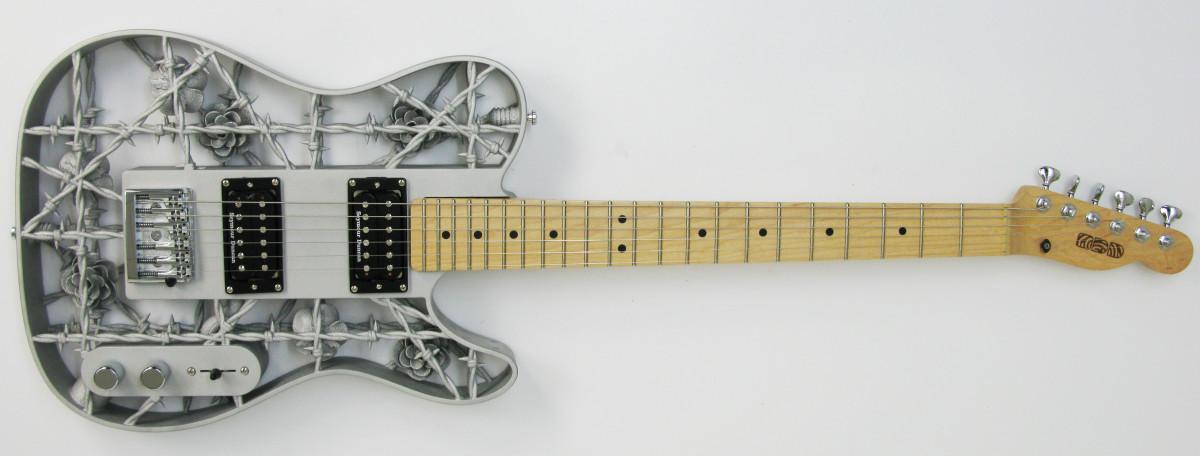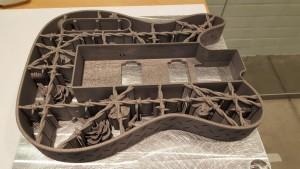Aluminum is the most commonly found metal on Earth, and after oxygen and silicon, it is the third most commonly found element. Because of its low density, resistance to corrosion and its ability to easily be combined with other metal materials, aluminum is also one of the most important industrial metals around, and is invaluable to the production of aerospace and automobile components. It is also one of the materials that can easily be used for 3D printing with metal using selective laser sintering technology. Because it is capable of generating virtually any geometry, SLS has been used to 3D print some of the most advanced metal parts ever designed. And now it has been used to 3D print the body of an incredibly beautiful guitar named “Heavy Metal.”
Heavy Metal was created by Sweden-based artist and designer Olaf Diegel for his 3D printed guitar company Odd Guitars. Diegel created it to explore what exactly metal 3D printing can do, how it can be used and where its limitations lay. He intentionally made the design extremely complex so he could push the limits of the process and create something that would be completely impossible without it. The result is an incredible Telecaster-style guitar body with a diamond tread-plate outer rim and an internal structure made of barbed wire and roses.
Diegel designed Heavy Metal using Solidworks and then teamed up with Holland-based 3D printing service providers Xilloc to 3D print the body as one complete part. It was printed using an EOS M400 metal 3D printer, which is usually used to manufacture metal parts for engines and industrial machinery. Diegel originally nicknamed this project “War and Peace,” but while doing the laborious post-processing work that was required on the printed body it became clear that Heavy Metal was a more appropriate name.
The SLS process that Xilloc used was pretty simple: a thin layer of aluminum powder was spread out on a metal base-plate, and a laser melted the powder onto the base-plate layer-by-layer until the entire guitar body was complete. While the SLS process can be used for a wide range of materials, from plastics to nylons to metals, it works very differently depending on exactly what material is being sintered. Typically when plastics are sintered, there is no need for any sort of support material because the powder itself acts as a support. But when metal is used and the geometry of the part is especially complex, the heat used to melt the metal together can actually cause weak spots or heat stresses that could result in the part breaking or warping.
In order to prevent this, the 3D object is printed with support structures that run down to the base-plate; however, they are really just heatsinks. The support structures will transfer the heat away from the guitar body down to the base-plate, preventing any weak spots from forming. Unfortunately that means that all of that support material will need to be removed, and because Heavy Metal had such a complex design, all of it had to be done by hand. The first step was using a metal-cutting saw to cut the base-plate off of the main guitar body. Then Diegel needed to go in and cut away all of the leftover heat-transferring structures, a process that took him four days to complete.
When metal is 3D printed using SLS, it doesn’t come off of the printing bed smooth or even particularly attractive. With aluminum, the finish is a dull gray that has a very rough, sand-like feel to it and it will need to be heavily processed to both look attractive and feel good to the touch. After Diegel removed all of the supports, he started the process of smoothing the finish, mostly by hand. He started with a series of small files that could get into all of the guitar body’s details, and also did a lot of sanding, which took him another four days. Next he put the body into a machine that shot-peened it with glass beads to give it a satin finish and remove any lingering rough spots.
Once the body was completed, Diegel only needed to assemble the rest of the guitar, including the CNC milled wooden inner core, the neck, the bridge and the various electronics. The result is a work of art, and a guitar that would do any rock star proud. Once assembled, Heavy Metal only weighs about eight pounds, which is why a lightweight metal like aluminum was chosen. Diegel detailed the entire design, printing, post-processing and build process over on his website, where you can also see some of the other amazing guitars that he’s created – like this one played by the Steve Miller Band’s Kenny Lee Lewis, or these ones he designed for the first-ever concert featuring all 3D printed instruments. He’s also 3D printed a working saxophone, and just recently helped one of his Lund University students to develop a new method of 3D printing prosthetics; you’d definitely be justified in calling Diegel a true 3D printing Renaissance man. What do you think of the guitar? Discuss in the 3D Printed Heavy Metal Guitar forum over at 3DPB.com.
Subscribe to Our Email Newsletter
Stay up-to-date on all the latest news from the 3D printing industry and receive information and offers from third party vendors.
You May Also Like
3D Printing Unpeeled: New Arkema Material for HP, Saddle and Macro MEMS
A new Arkema material for MJF is said to reduce costs per part by up to 25% and have an 85% reusability ratio. HP 3D HR PA 12 S has been...
3D Printing News Briefs, January 20, 2024: FDM, LPBF, Underwater 3D Printer, Racing, & More
We’re starting off with a process certification in today’s 3D Printing News Briefs, and then moving on to research about solute trapping, laser powder bed fusion, and then moving on...
3D Printing Webinar and Event Roundup: December 3, 2023
We’ve got plenty of events and webinars coming up for you this week! Quickparts is having a Manufacturing Roadshow, America Makes is holding a Member Town Hall, Stratafest makes two...
Formnext 2023 Day Three: Slam Dunk
I’m high—high on trade show. I’ve met numerous new faces and reconnected with old friends, creating an absolutely wonderful atmosphere. The excitement is palpable over several emerging developments. The high...




































